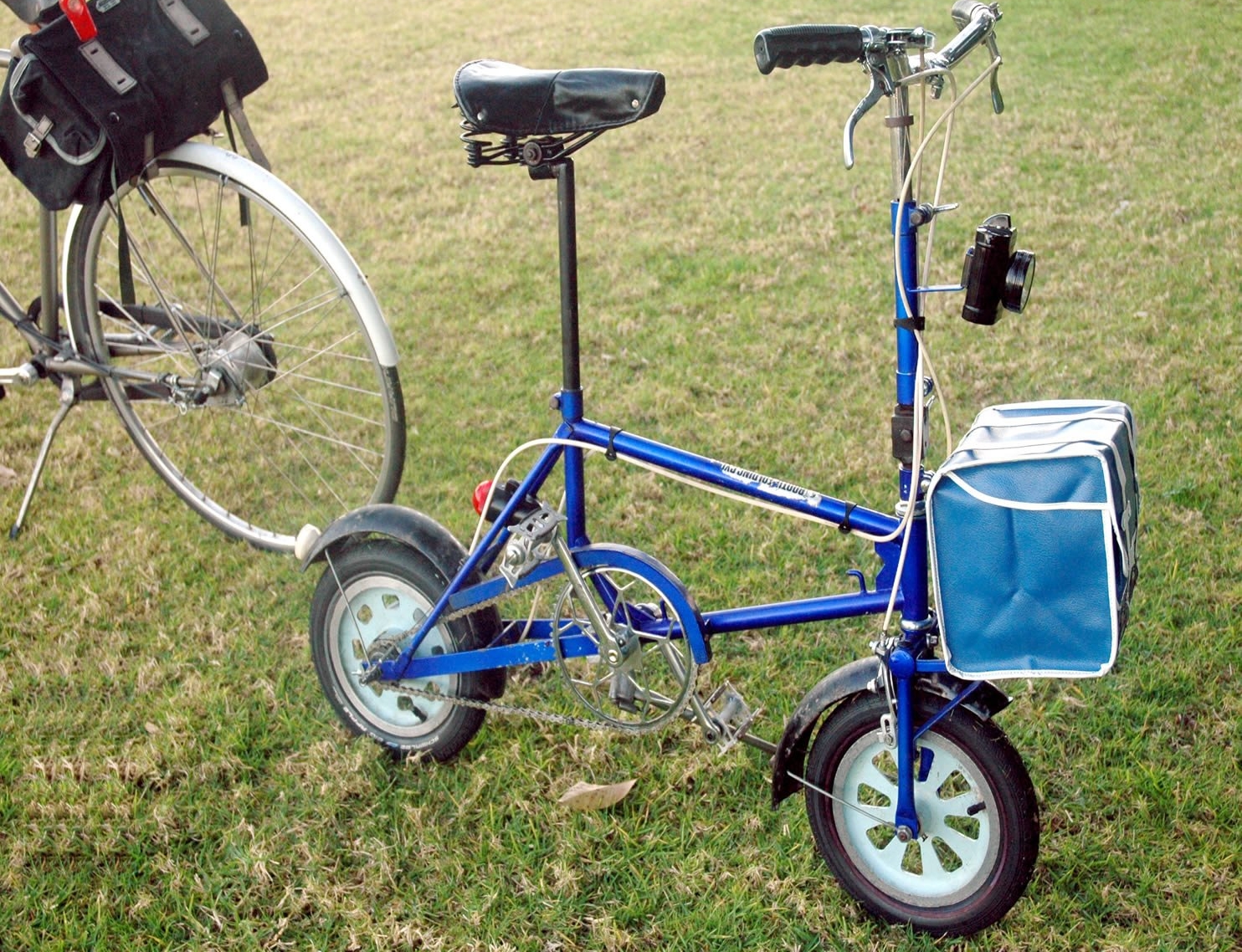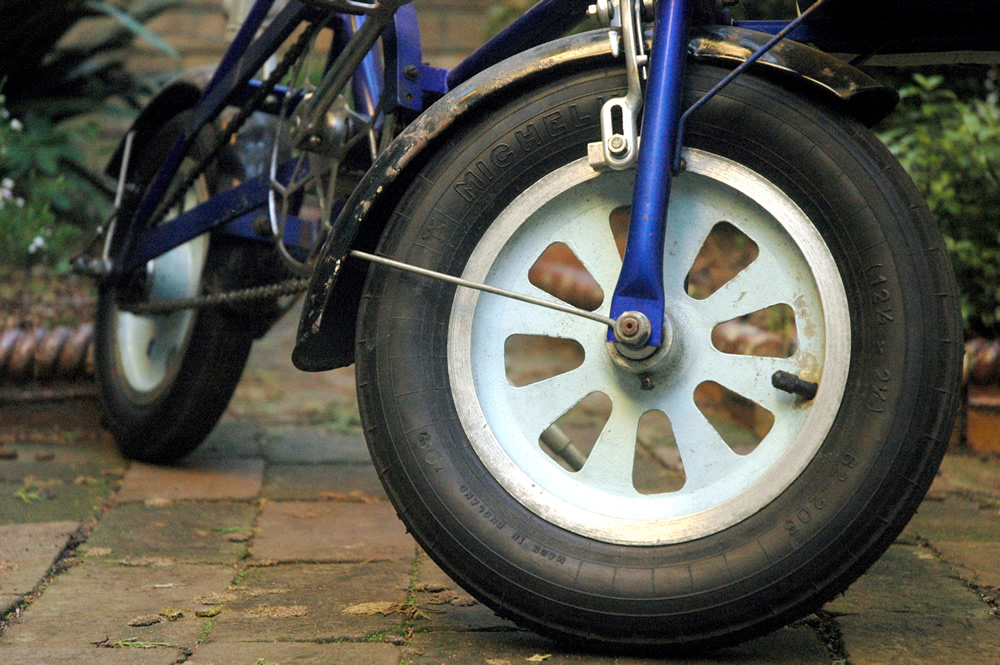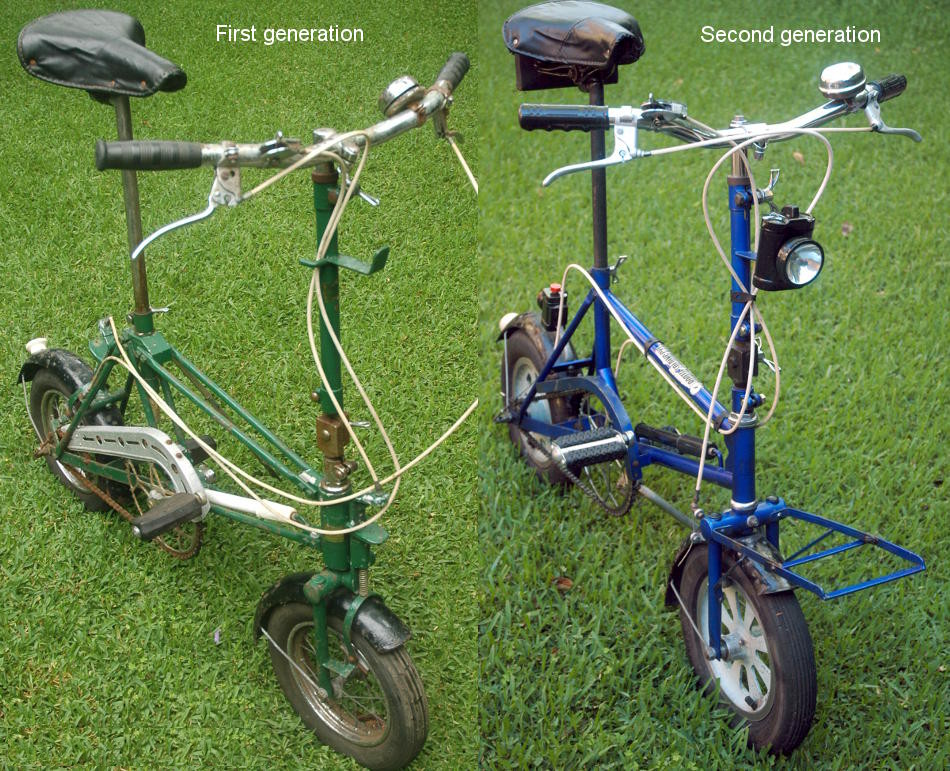Bootie (bicycle) on:
[Wikipedia]
[Google]
[Amazon]
 The Bootie Folding Cycle, or 'Bootie', is a rare
The Bootie Folding Cycle, or 'Bootie', is a rare
 It was primarily designed for ‘last mile’ purposes, but the advertising also appealed to caravanners, boat owners, flat dwellers and fishermen. The slogan ‘As a dinghy is to a boat, so is the Bootie to a car’ was used to promote the Bootie.
The ‘Bootie’ name was chosen because the bike was designed to be small enough to store in the
It was primarily designed for ‘last mile’ purposes, but the advertising also appealed to caravanners, boat owners, flat dwellers and fishermen. The slogan ‘As a dinghy is to a boat, so is the Bootie to a car’ was used to promote the Bootie.
The ‘Bootie’ name was chosen because the bike was designed to be small enough to store in the
 Each hinge was secured with a hand nut which, when loosened, allowed the upper part to be swung over the side of the frame. In the case of the steerer tube, loosening another hand nut allowed the handlebars to be rotated 90 degrees to fit snugly against the side of the bike.
Only the very earliest examples had both a hinged seat tube and handlebar stem. Within a year or two of introduction the hinged seat tube was replaced by a conventional seat tube with a long seat post that could be slid down or removed altogether. The lower end of the seat tube was open, and to the rear of the
Each hinge was secured with a hand nut which, when loosened, allowed the upper part to be swung over the side of the frame. In the case of the steerer tube, loosening another hand nut allowed the handlebars to be rotated 90 degrees to fit snugly against the side of the bike.
Only the very earliest examples had both a hinged seat tube and handlebar stem. Within a year or two of introduction the hinged seat tube was replaced by a conventional seat tube with a long seat post that could be slid down or removed altogether. The lower end of the seat tube was open, and to the rear of the 
 The frame of the first generation Bootie was made of pairs of half inch steel tubes, with the flattened tube ends bolted to aluminium head, saddle and bottom bracket castings. The chainstays were of flat steel strip.
The first generation bikes had wire wheels. Braking was by unique, Kitchin-made stirrup brakes designed with extra leverage to give more braking power than was otherwise available with the tiny wheels. A Sturmey Archer ‘AW’ three speed gear was fitted.
The frame of the first generation Bootie was made of pairs of half inch steel tubes, with the flattened tube ends bolted to aluminium head, saddle and bottom bracket castings. The chainstays were of flat steel strip.
The first generation bikes had wire wheels. Braking was by unique, Kitchin-made stirrup brakes designed with extra leverage to give more braking power than was otherwise available with the tiny wheels. A Sturmey Archer ‘AW’ three speed gear was fitted.
Folding bike history
Travel with Bikes - Folding Bicycles
- Includes photographs of many parts of a Bootie undergoing restoration {{British bicycle manufacturers Cycle types Cycle manufacturers of the United Kingdom Folding bicycles
folding bicycle
A folding bicycle is a bicycle designed to fold into a compact form, facilitating transport and storage. When folded, the bikes can be more easily carried into buildings, on public transportation (facilitating mixed-mode commuting and bicycl ...
produced in West Yorkshire
West Yorkshire is a metropolitan and ceremonial county in the Yorkshire and Humber Region of England. It is an inland and upland county having eastward-draining valleys while taking in the moors of the Pennines. West Yorkshire came into exi ...
UK from 1965 to 1973. Manufacturer
The Bootie Folding Cycle was designed by Thomas Kitchin and made by F. T. Kitchin of Vickersdale Works, an old industrial estate in Grove Street,Stanningley
Stanningley is a district of Pudsey, West Yorkshire, England. It is situated approximately west of Leeds city centre on the A647 road, the original main road from Leeds to Bradford. The appropriate Leeds Metropolitan Ward is Bramley and Stann ...
, Pudsey
Pudsey is a market town in the City of Leeds Borough in West Yorkshire, England. It is located midway between Bradford city centre and Leeds city centre. Historically in the West Riding of Yorkshire, it has a population of 22,408.
History
T ...
.
F.T. Kitchin were general engineers who were in business for over 100 years. They have been described as relatively small, true 'jobbing' engineers who were very quirky and willing to make, or 'invent', whatever wasn't generally available, but never big enough to develop their products in the way a larger firm would.
Marketing
The Bootie was sold directly via advertising in the cycle press. In the December 1966/January 1967 issue of ''Cycletouring'' Magazine it was priced at £25.10.0 (inc. tax), delivered. It was primarily designed for ‘last mile’ purposes, but the advertising also appealed to caravanners, boat owners, flat dwellers and fishermen. The slogan ‘As a dinghy is to a boat, so is the Bootie to a car’ was used to promote the Bootie.
The ‘Bootie’ name was chosen because the bike was designed to be small enough to store in the
It was primarily designed for ‘last mile’ purposes, but the advertising also appealed to caravanners, boat owners, flat dwellers and fishermen. The slogan ‘As a dinghy is to a boat, so is the Bootie to a car’ was used to promote the Bootie.
The ‘Bootie’ name was chosen because the bike was designed to be small enough to store in the boot
A boot is a type of footwear. Most boots mainly cover the foot and the ankle, while some also cover some part of the lower calf. Some boots extend up the leg, sometimes as far as the knee or even the hip. Most boots have a heel that is c ...
(''trunk'' in American English) of a car. Design
Strictly speaking, the Bootie was not really a ''folding'' bike. More accurately, it was a very small, rigid-framed bike with folding handlebars and seat post. It was therefore a revival of a concept pioneered by the French ‘Le Petit Bi’ in the late 1930s. The Daewoo Shuttle is a more recent example of the type.Folding mechanism
The Bootie featured a then-unique way to fold the handlebars and seat out of the way. This comprised a solid steel, two-parthinge
A hinge is a mechanical bearing that connects two solid objects, typically allowing only a limited angle of rotation between them. Two objects connected by an ideal hinge rotate relative to each other about a fixed axis of rotation: all other ...
fitted midway on the steerer and seat tubes.
bottom bracket
The bottom bracket on a bicycle connects the crankset (chainset) to the bicycle and allows the crankset to rotate freely. It contains a spindle to which the crankset attaches, and the bearings that allow the spindle and crankset to rotate. The ...
, to allow the seat post to slide all the way down.
With the change to a conventional seat tube the only part of the Bootie 'Folding' Cycle that actually folded was the steerer tube (i.e. the handlebars).

Equipment
The Bootie Folding Cycle came well-equipped, with mudguards, a built in luggage rack, front and rear lamp brackets and sidestand. Thecrankset
The crankset (in the US) or chainset (in the UK), is the component of a bicycle drivetrain that converts the reciprocating motion of the rider's legs into rotational motion used to drive the chain or belt, which in turn drives the rear wheel ...
is a steel, cottered mass market unit manufactured by Williams, and the handlebars and stem are conventional chrome plated steel. A black double sprung mattress type saddle
The saddle is a supportive structure for a rider of an animal, fastened to an animal's back by a girth. The most common type is equestrian. However, specialized saddles have been created for oxen, camels and other animals. It is not kno ...
was fitted to the 500 mm long 'L' shaped seatpost. Booties were shod with Dunlop or Michelin ETRTO size 203 - 62, balloon-type tyres.
Dimensions
Thewheelbase
In both road and rail vehicles, the wheelbase is the horizontal distance between the centers of the front and rear wheels. For road vehicles with more than two axles (e.g. some trucks), the wheelbase is the distance between the steering (fron ...
was 76 cm (compared to around a metre for conventional bicycles), with an overall length of 120 cm with the foldable front rack extended. The Bootie weighed around 17 kg.
Model history
The Bootie was produced for in two ‘generations’: the first from 1965 to 1968, the second from then until the end of production.First generation
 The frame of the first generation Bootie was made of pairs of half inch steel tubes, with the flattened tube ends bolted to aluminium head, saddle and bottom bracket castings. The chainstays were of flat steel strip.
The first generation bikes had wire wheels. Braking was by unique, Kitchin-made stirrup brakes designed with extra leverage to give more braking power than was otherwise available with the tiny wheels. A Sturmey Archer ‘AW’ three speed gear was fitted.
The frame of the first generation Bootie was made of pairs of half inch steel tubes, with the flattened tube ends bolted to aluminium head, saddle and bottom bracket castings. The chainstays were of flat steel strip.
The first generation bikes had wire wheels. Braking was by unique, Kitchin-made stirrup brakes designed with extra leverage to give more braking power than was otherwise available with the tiny wheels. A Sturmey Archer ‘AW’ three speed gear was fitted. Second generation
The second generation Booties had a different frame and wheels. The frame was mostly of tubular steel without lugs, but the chainstays were still made of flat steel strip. Thewheels
A wheel is a circular component that is intended to rotate on an axle bearing. The wheel is one of the key components of the wheel and axle which is one of the six simple machines. Wheels, in conjunction with axles, allow heavy objects to b ...
were of single-piece cast alloy, the front being equipped with sealed ball races, possibly a first for the industry.
An alloy GB T91 Sprite caliper brake was employed at the front, while the rear brake was of the internal expanding type, integral with the three speed gear in the Sturmey Archer ‘AB’ hub. It appears as though the drive side flange of the hub was removed for fitting in the wheel.
References
External links
Folding bike history
Travel with Bikes - Folding Bicycles
- Includes photographs of many parts of a Bootie undergoing restoration {{British bicycle manufacturers Cycle types Cycle manufacturers of the United Kingdom Folding bicycles